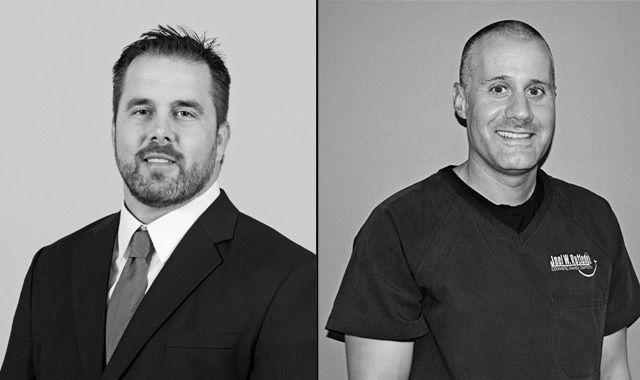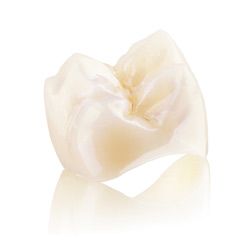The reality of digital in the dental workflow
Daxton Grubb and Dr. Joel Rutledge discuss how going digital has presented their businesses with new opportunities-and new challenges.

R-Dent Dental Laboratory is a full-service lab located just outside Memphis, Tennessee. It’s a family-owned lab, in service since 1978. When lab president Daxton Grubb (pictured above, left) joined R-Dent in 2001, he was coming out of college as a business and economics major, and he saw that his father’s business was struggling to transition from a traditional fixed-only lab. Under Grubb’s leadership, R-Dent added a removables department, grew its staff to 50, and embraced the digital workflow.
One of R-Dent’s clients is Dr. Joel Rutledge (pictured above, right), a family and cosmetic dentist in Memphis. Dr. Rutledge does general dentistry along with implant cases. He has adopted a digital workflow in his practice, using an intraoral scanner to send digital files to R-Dent.
Related reading: How Zahn Dental brings digital technology to every lab
We recently spoke with Grubb and Dr. Rutledge about how the digital process has changed their businesses, how going digital has changed the way they work, and how digital tools and materials can be used to create beautiful results and happy patients. Here’s what they told us:
Tell us a little bit about yourself.
Zirlux 16+ crowns

Grubb: I joined R-Dent in 2001 and at the time we were just an eight-man, fixed-only lab. Shortly after I joined the lab, we added the removable department-we had some really good years, and we grew to a lab of 50 employees. We do everything on-site, and we don’t outsource anything except abutments and bars. We’re definitely heavily involved on the technology side. I have six mills, two 3D printers, and four different CAD systems, so we’re about 28 percent fully digital. We’re using the Zirlux 16+ for our high-strength full-contour zirconia. We just changed over to those, and we use Katana for our high-translucency zirconia.
Dr. Rutledge: I graduated from the University of Tennessee dental school in 2002. I have been in solo private practice since 2004. My practice is in Memphis, Tennessee. The practice’s focus is pretty much bread and butter dentistry. Also, we do quite a lot of implants from start to finish.
What was the transition like from a traditional workflow to a digital workflow?
Grubb: I think some of the struggles are trying to convince people that the purpose of the technology is not to take their jobs—it’s to put into practice a LEAN manufacturing mentality, to become as efficient as we can. We need technicians to evolve, but if they’re smart they’re going to bring the skills they already have into CAD/CAM or into other digital arenas.
Must read: Zahn's latest comprehensive CAD/CAM line
Dr. Rutledge, how did you make sure that the tools you were acquiring would work with your dental team and patients?
Dr. Rutledge: When I was looking at going digital/scanning I was able to view and use a few different models. My main question was which scanner the lab suggested. I wanted to have the scanner they were the most familiar with. The lab and I have been able to learn all of the intricacies of the scanner together. They may figure out something that the scanner does really well and vice versa
What are some advantages and stresses of a full digital workflow?
Grubb: I think we’ve seen a big push in model-less restorations. That’s definitely a game-changer. We’re not printing models so it’s a three-day, in-and-out turnaround. We’re being pushed to not only be constantly changing, but we’re changing protocols and workflow so we’re having to question everything to see if it’s the optimal workflow and layout. We’re right now looking at doing split shifts to maximize our capital expenditures. When you buy this equipment, being able to use it over a longer period pays off. I think we’re doing well but we have a lot more to go to become as efficient as we can. I definitely believe in the quality of the work we’re getting out versus the PFMs we were working on before; the restorations are more esthetic, more dependable than what we were doing.
Business news: Henry Schein acquires CAP
I think it’s something that people have to understand: Any time you bring in technology, it’s always a learning curve. Sometimes [manufacturers] communicate the ideal situation-and sometimes you can bring in a machine and it becomes your nightmare, which is a real opportunity cost! Understanding all of this technology takes a lot of attention, effort and nurturing-I think you’re still coming out better, but people shouldn’t feel like they could replace their technicians and everyone is happy. I’ve yet to this day to let go of one technician because of one piece of equipment we’ve bought.
A Zirlux crown.

Dr. Rutledge: There are many advantages to using the digital workflow. I believe the scanner itself is much easier on the patient. The patients also marvel at how “high-tech” the office is. As for the actual product, the scanner makes remakes pretty much a thing of the past. The margins on crowns are perfect. If you can’t see the margin on the screen then I promise the lab can’t either. It’s really easy to fix that though, as you just erase the area in question and rescan it until the margin is clearly defined. The fit of the crowns is also great. The occlusion hardly ever needs to be touched.
What should labs and dental offices look for when purchasing equipment or digital materials from a reseller?
Dr. Rutledge: This has been the one really true problem with this technology. The best scanners [often] have resellers who are really behind the curve on support for the scanner. I would make sure that your reseller has sold a fair amount of the product and has a dedicated digital support person. I would also make sure that the reseller is able to quickly get in touch with the manufacturer for support or upgrades etc., because as you will soon find out after making the transition to digital and fully committing to it, you can’t really live without it.
Grubb: We’ve bought equipment that has wowed us with its level of support, and I’ve had big pieces of equipment where the support is nightmare. I recommend when people look at buying equipment, you almost have to put equal effort in who you’re buying it for. You might be better off buying lesser equipment from a better support company than a better piece of equipment with poor support.
We buy all of our materials from Zahn Dental. I bought a piece of equipment from another vendor, and when it failed, Zahn helped me find the company and they helped me get a new one. There’s just nobody that can do the things they do. They’re the only people out there that are able to deliver to the customers what we need. It’s hard to not engage with that kind of assurance-and measure what that’s worth. They’re a resource and a real partner, and they don’t try to hold that over your head.
Click here to read all about Zirlux 16+
How do you make a digital material look great?
Grubb: What we’ve found with Zirlux 16+ is that we’ve got the shades in a disc. If it’s a base shade, we’re not having to do hardly anything to it. It’s polish, a glaze and go. If you have to convert to a 3D master shade or a split shade, that’s where you have to get heavy on the external shading piece.
But I think the full contour zirconia market has gotten very commoditized. A lot of these materials are so close to the final product. I think Zirlux is an excellent product, but when looking at others that are pre-shaded, they’re close, so it falls back again on who are you buying from. Other options can’t support me like Zahn can. Zahn can do so much for me.
What would you say to another dental professional who is thinking about going digital?
Dr. Rutledge: I would say just do it. You won’t regret it. There is a slight learning curve; you have to rethink some things that were ingrained in you since dental school, but the final product is really worth it. And the advancements that are coming out every day from the scanner manufacturers make it really exciting to be on the cutting edge of dental technology.